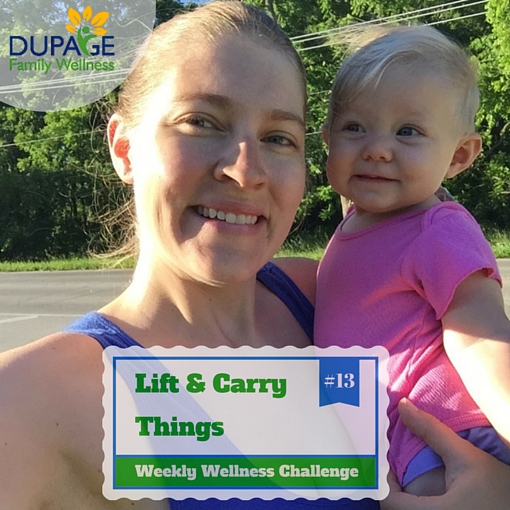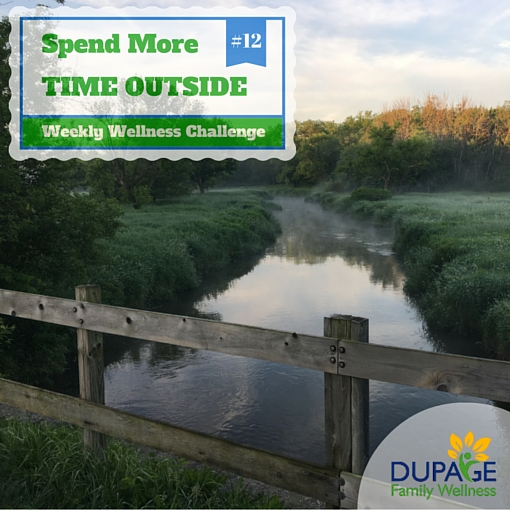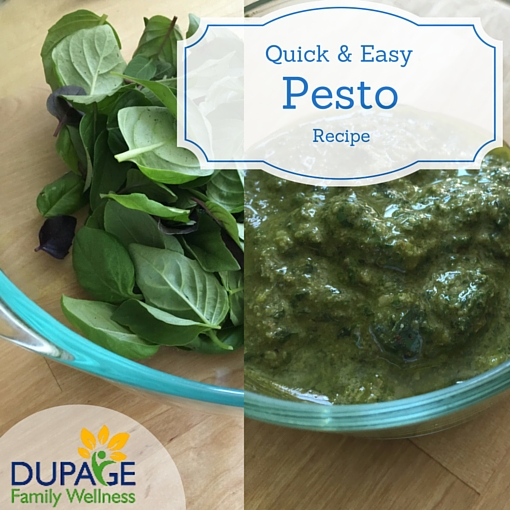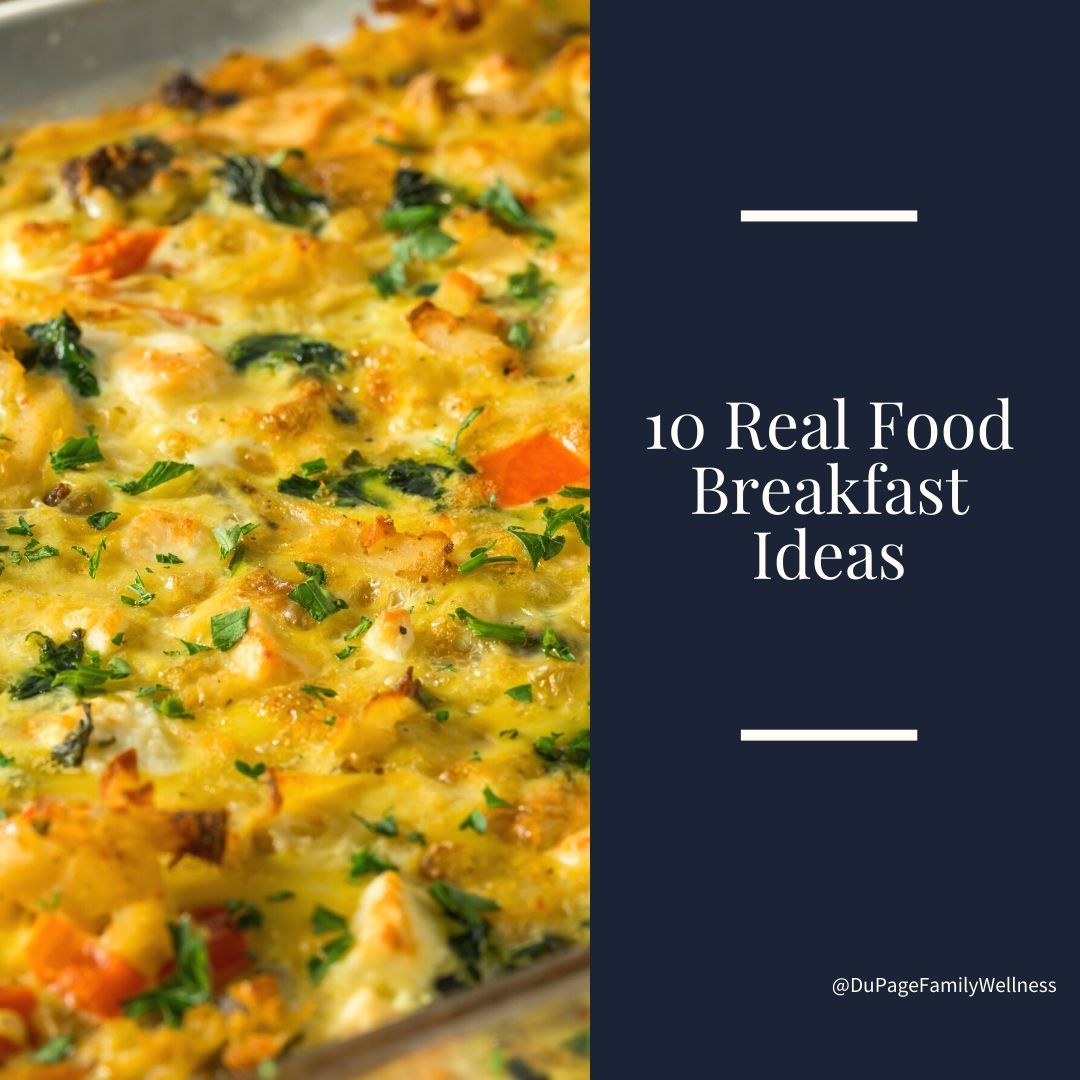Our challenge this week seems simple, but might take some creativity to figure out how to add more lifting into your life!
The most important takeaway this week is to re-frame the way you think about lifting things. Once again, we are going to think about what our ancestors used to do. There are so many modern day conveniences that allow us to avoid lifting anything. I encourage you to be conscious of these conveniences and when possible avoid them so that you use your muscles actively throughout the day!

Until a few weeks ago, I never really thought about any of this. Like most people in our country, I would have told you that if you want to lift things, go to the gym. I recently heard a story about having a beach ready body that really resonated with me. A beach body should not be one that simply looks good in a swim suit. A beach ready body is one that is "functional" at the beach. It is a body that if someone were struggling out in the waves, could run, swim, and pick up and carry the struggling person to safety. Often by default if you can do these things well, you probably also look good in the swimsuit, but that is an added bonus.
So what is the best way to get this “functional” beach body? Carry things, move your body, keep your muscles in your body active and engaged as much as possible.
Step 1) Move more- we already talked about this a few weeks ago- so I’ll link back to that article
Step 2) Carry things while you move!
One of the great things about carrying things while you move your body is that you will naturally shift constantly activating all sorts of different muscle groups. If you go to a gym and do a bicep curl machine for example, you work 1 muscle in 1 plane. This doesn’t translate very well to real life movement since there aren’t many situations in which you only have to control something that you lift in one direction with one muscle group. If you take a walk while carrying something you work your whole upper body in all 3 planes!
Lifting/carrying things doesn’t just mean objects- this can mean lifting your body as well. Throughout the course of the day, your muscles will be active a much higher percentage of the time if you are moving, walking, or even sitting unsupported (aka not sinking into a couch or Lazyboy where all of your mucles can just turn off). By sitting on the floor or a stool, you will constantly be shifting your body and keeping your core engaged!
So now that I’ve got you thinking a little bit differently about lifting things and keeping your muscles engaged throughout the day- what are some ways to do this?
- Carrying food- bring your own bags to the grocery store, and carry your food instead of using a cart
- Carrying children- I have been going for walks carrying my 20 pound baby instead of pushing her in a stroller. This way I get an upper body workout- and she does too! In the stroller, she can just turn off all of her muscles instead of supporting her head and torso.
- Carrying water- got a garden? Try watering manually instead of using a hose or a sprinkler
- Carrying supplies on your hike. If you are going for a walk- grab a sack or a pillow case and throw your water and snacks in there. While this is slightly less comfortable than a backpack, carrying it will involve constantly shifting positions and arms which allows different muscle groups to activate! At stopping points, you can swing your sack like a homemade kettle bell!
- Lift your body by doing something like rock climbing, or even playing on the monkey bars at a local park!
- Keep your muscles engaged by standing, sitting on the floor, or sitting in a backless chair/stool instead of sinking into a comfy couch.
- If you have a desk job, try a standing desk at work
- Laundry- lifting/carrying laundry baskets/clothes can be a great workout!
- Cleaning- instead of using a device like a vacuum or a broom, get down on the floor to clean floors
- Go swimming! This is a great way to engage muscles throughout your body (and important if you want that beach body ready that is able to rescue the drowning swimmer!)
What about the gym?
I am not trying to tell you not to go to the gym. I think that this can be a great place to activate your muscles. There are 2 things that worry me about the gym. First of all, I want to shift your thinking from sleeping/sitting 23+ hours a day and moving only during that 30-60 min gym session. I think that movement and muscle engagement should be something we are striving to do as much as possible while we are awake! My second concern about the gym is that people often do exercises that don’t translate well into real life movements. I want you to do movements that mimic things you have to do in real life- not simply getting on an elliptical machine or doing weight machines that isolate one muscle group at a time in one plane. The gym is a great addition to an active lifestyle, but should not be your only activity throughout the day!
So there you have it! I hope you are starting to change the way you think about movement and activity throughout the day. This week try to use at least one of our suggestions to “lift things”- including your own body more often! Let us know how it goes on our facebook page!!
What simple lifestyle change can help you sleep better, see better, and feel happier?
 Can you guess the answer? It is spending more time outside! Keep reading to learn why.
Can you guess the answer? It is spending more time outside! Keep reading to learn why.
In Dr. Jamie’s recent post titled "Move More - Move Better", I noticed that her suggestions (walking, hiking, gardening, etc) not only were to move, but to move OUTSIDE.
In general, the current generation spends less time outside than previous generations. This is one of many factors contributing to the decline of health in modern people.
How Does Being Outside Affect Your Health?
Sleep
Think about days where you are outside most of the day. You may have worked hard hiking in the woods or relaxed at the beach with friends. Either way, at the end of the day, you felt tired and probably had a great night’s sleep. This correlation between a good night’s sleep after being outside all day is not a coincidence. Our body’s circadian rhythms are how our bodies know what time it is. They let the body know when it’s time to wake up and when it’s time to sleep.
The most important factor controlling circadian rhythms is exposure to light. The natural light from outside is different from indoor light. To properly set the rhythms of your body, you need to spend time in natural light during the day and avoid unnatural light at night. By doing so, your body will naturally fall into the rhythm of nature and be ready to awake when the sun rises and be winding down when the sun sets. This provides the best opportunity for quality sleep.
I can personally attest to these improvements. My goal has been to be outside with my 5 month old as much as possible when she is awake. Once we developed this habit, her body almost immediately began a very regular sleep cycle and she’s been easily going to bed every night and sleeping great.
Myopia (Nearsightedness)
When I was a kid, only a few of my classmates wore glasses. Over the last couple of decades there has been a huge increase in myopia, specifically in industrialized countries. In biomechanist, Katy Bowman’s book Move Your DNA, she says
“Research shows that cultures historically without books show an increase in nearsightedness once reading or other hallmarks of a “civilized” environment (like night-lighting) are introduced. But more recent research specifically looking at reading shows that time spend outdoors might be the factor worth looking at instead.”
She goes one to talk about how the loads on your eyes changes depending on how far you are looking. If you are inside most of the day, even if you aren’t looking at a book or screen, you only look 20-30 feet at most. This close looking it causes the ciliary muscles in your eyes to contract. If you spend too much time looking at short distance, it does not give your eyes the chance to create a different load by looking far distances. The action of looking far away causes the relaxation of these tense eye muscles. Read more on myopia and the ciliary muscles.
General Well Being
In addition to these two specific examples, there are several studies that link being outside in nature to general overall health. Being in nature has been found to restore your focus, help you relax, be great for your brain, and increase overall feelings of happiness.
What are some practical ways to add more outdoor time to your life?
- Eat outside! You have to eat anyways, so why not eat outside. It can be a quiet breakfast or cup of coffee on the deck in the morning, lunch at a park with a coworker, or a family dinner outside.
- Move outside! Follow the examples in Dr. Jamie's previous post. Move More - Move Better. Instead of hitting the gym, spend more time moving outside in nature.
- Get a dog. I realize this might not be for everyone, but since getting our dog a year and a half ago we go on so many more walks out of necessity for him and overall enjoyment for the whole family!
- Meet a friend outside! Instead of meeting at the local coffee shop, find a park outside to chat, or take a walk instead.
- Take your phone calls outside! When I have to make one of those phone calls where I expect to be on hold for many minutes, I try to make the call while going for a walk. It makes the wait more enjoyable!
If you start paying attention to how much time you spend inside, you might be surprised. Use your ingenuity to figure out ways to get yourself outside.
Your challenge for the week: Try one or more of these ideas to add more outdoor time to your life.
Joelle Kurczodyna, NTP
 One of my goals this summer is to keep up with harvesting, so that I reap all of the benefits of our small, backyard garden. We planted quite a bit of basil and it is already big enough to harvest. I have learned that the more leaves you pick, the more they grow. You can harvest it many times - learn more about growing and harvesting basil.
One of my goals this summer is to keep up with harvesting, so that I reap all of the benefits of our small, backyard garden. We planted quite a bit of basil and it is already big enough to harvest. I have learned that the more leaves you pick, the more they grow. You can harvest it many times - learn more about growing and harvesting basil.
What is the best way to use an abundance of basil? Make pesto, of course!
An awesome benefit to cooking with herbs is that you get an abundance of the green vegetable color profile in a different way than your typical salad or broccoli side dish. Pesto is a delicious topping for chicken, fish, spaghetti squash, or spiralated zucchini.
This is a quick and easy pesto sauce, using ingredients that you probably have on hand. Make double or even bigger batches when basil is plentiful. The pesto freezes well and I love having the fresh garden taste during the winter. Freeze in ice cube or small muffin cups. Once frozen, empty them into another container and keep in the freezer until needed.
Simple Pesto
Yield: ½ cup pesto
Ingredients:
- 1 cup of packed basil leaves
- ¼ cup of walnuts (pine nuts, cashews, or another kind of nut works well too)
- 1-2 chipped garlic cloves
- ¼ cup extra virgin olive oil
- Salt and pepper to taste
Directions:
In a food processor combine basil, walnuts and spices until blended thoroughly. Pour in olive oil and blend again until mixture has reached desired consistency.
Store in refrigerator for up to one week or freeze for later use.
Enjoy!
Article by: Joelle Kurczodyna, NTP
 Move More - Move Better
Move More - Move Better
I saw an Instagram post earlier this week (follow me @docjthomure ) that resonated with me. The poster was Dallas Hartwig, one of the creators of the Whole 30 program where you eat real unprocessed foods for 30 days. Dallas discussed his movement while growing up. It included working in the family garden, traveling to the mountains to hike, mountain biking, canoeing, and swimming. His life was full of healthy movement, in spite of the fact that it did not include any planned or structured "exercise".
Dallas pointed out that “health is not dependent on doing tons of hard, structured exercise, and in a lot of cases hard training actually DECREASES health.” This idea has been trending in other research as well.
Many lean, fit, and muscular people have health problems that include gut issues, insomnia, fatigue, anxiety, chronic inflammation, thyroid problems, or depression. These people chase “fitness” with an intense structured exercise regimen, but it often leads to decreased health. I would rather be "healthy", meaning free of disease or injury, than have 6 pack abs that look good in the mirror, but are accompanied by underlying health conditions.
The Copenhagen City Heart Study explores the relationship between jogging and all cause mortality. They found that light and moderate joggers had lower mortality than sedentary people, but strenuous joggers had the same mortality rate as sedentary non-joggers.
Movement is an important component of overall health. People that move more throughout the day in functional ways will be healthier than those that go to the gym and beat themselves up with a repetitive workout for 45 minutes (especially if their one bout of movement is sandwiched between a desk job and an evening in front of the TV). These days, a desk job can be unavoidable. If this is your reality, walk, do squats, take the stairs, get a standing desk, and leave your desk as much as possible throughout your work day.
What are healthy functional movements?
Move more like your ancestors used to move! Just like we've discussed eating like our ancestors, we should also move like them. Functional movements will you help you to improve strength, improve mobility, and improve stability. For example:
- Walk
- Pick up something heavy and carry it
- Plant a garden and tend to it (squat)
- Climb a tree
- Build something
- Chase something
- Swim
- Paddle a boat
- Ride a bicycle
- Dance
- Play with your kids- or just act like a kid!
While this advice may seem unconventional, it is your challenge this week. Add healthy functional movement to your life each day. If you spend as much time moving as our ancestors used to (and by default less time at a desk/on a computer/watching TV, etc.) - it will lead to better health!
Dr, Jamie Thomure
 Once you decide to eat real, unprocessed foods, breakfast can be a roadblock. Most people are pressed for time in the morning but still want a quick and easy, yet satisfying breakfast. In light of this, people routinely turn to milk and cereal as a quick option. Keep reading for some better ideas.
Once you decide to eat real, unprocessed foods, breakfast can be a roadblock. Most people are pressed for time in the morning but still want a quick and easy, yet satisfying breakfast. In light of this, people routinely turn to milk and cereal as a quick option. Keep reading for some better ideas.
What’s wrong with cereal and milk?
There are 2 big reasons to avoid the standard milk and cereal breakfast.
- Cereal is not a "real food". Read the ingredient label on any cereal box, even the whole grain and organic varieties. The list usually includes some form of added sugar, along with 20-30 ingredients, many of which you cannot pronounce.
- Cereal is primarily carbohydrates, which your body converts to glucose (sugar). This is a quick burning source of fuel that gives you a surge of energy, but it only lasts for a couple of hours and then you are starving and tired again. You might find yourself heading to the break room for more coffee and a pastry. To avoid that crash, breakfast should include long-burning fuel sources provided by proteins and fats. This will keep you satisfied until lunch.
What About Oatmeal?
Steel cut or old-fashioned oatmeal passes the "real food" test, but it is a "filler" like rice or potatoes, that contains mostly carbohydrates (56 grams in a cup), and not many other nutrients. Although oatmeal is better than processed cereal, you may find that it does not have the fat and protein to keep you satisfied all morning. Read more about the pros and cons of oats.
The flavored oatmeal that comes pre-packaged in single servings is NOT real food. It contains many artificial ingredients, and added sugars just like other pre-processed cereals.
What About Eggs?
Traditionally, the recommendation has been to avoid eggs to keep your cholesterol down. Eggs have gotten a bad rap, but that is being reversed by current research. See Dr. Thomure's explanation of why you do not need to fear eggs.
Top 10 real food breakfast ideas:
10) Leftovers from the night before. While unconventional having soup or leftover meat & vegetables for breakfast is a good way to start the day.
9) Two-ingredient Banana and Egg Pancakes. (A quicker method that makes a custard-like concoction is to microwave the same ingredients. Mix the 2 eggs and 1 banana in a microwave-safe bowl. Cook for 1 minute on high power. Stir, mixing the cooked edges into the mixture. Cook for 2 additional minutes on power 5. Serve with butter and top with blueberries or strawberries. Yum!)
8) Ham and Egg Breakfast Cups - a super simple and delicious breakfast idea.
7) Breakfast Smoothie
6) Breakfast Skillet topped with an egg. (My favorite combo is sweet potato, spinach, onions, and a granny smith apple.) When the skillet is almost cooked, break one or more eggs on top and cover as it finishes cooking.
5) Full fat, PLAIN yogurt topped with fruit and nuts. You can even make easily make your own yogurt!
4) Avocado Egg Cups - a great way to incorporate healthy fats to keep you going all morning
3) My favorite Banana Bread or Muffins. Top with butter or nut butter to make it more filling.
2) Homemade Energy Bars - Make ahead for a grab-and-go breakfast.
1) Egg Casserole. This is our standard breakfast. I make it at the beginning of the week. I love it because it’s quick to reheat and an easy way to get eggs and veggies in the morning!
What are your favorite real food breakfasts?
Joelle Kurczodyna, NTP



 Can you guess the answer? It is spending more time outside! Keep reading to learn why.
Can you guess the answer? It is spending more time outside! Keep reading to learn why. One of my goals this summer is to keep up with harvesting, so that I reap all of the benefits of our small, backyard garden. We planted quite a bit of basil and it is already big enough to harvest. I have learned that the more leaves you pick, the more they grow. You can harvest it many times -
One of my goals this summer is to keep up with harvesting, so that I reap all of the benefits of our small, backyard garden. We planted quite a bit of basil and it is already big enough to harvest. I have learned that the more leaves you pick, the more they grow. You can harvest it many times -  Move More - Move Better
Move More - Move Better Once you decide to eat real, unprocessed foods, breakfast can be a roadblock. Most people are pressed for time in the morning but still want a quick and easy, yet satisfying breakfast. In light of this, people routinely turn to milk and cereal as a quick option. Keep reading for some better ideas.
Once you decide to eat real, unprocessed foods, breakfast can be a roadblock. Most people are pressed for time in the morning but still want a quick and easy, yet satisfying breakfast. In light of this, people routinely turn to milk and cereal as a quick option. Keep reading for some better ideas.